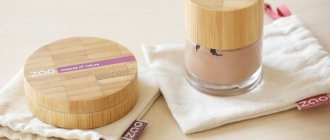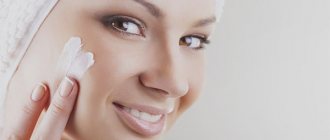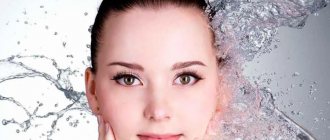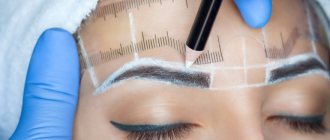Hello! Do you use creams with ceramides? Every year I invariably bought a well-known fluid until I found an analogue with an excellent composition and for less money! It's time to hand it over to you and share my personal experience =)
I am often asked where to start caring for sensitive skin or oily, problematic, age-related skin.
And it often happens that the skin is oily and at the same time dry, it tightens after washing, it reacts to literally everything.
In all these situations, ceramides should be one of the “building blocks” of proper care.
Do you know what this is?
Ceramides are the most important component of the lipid barrier: they perform a protective function, retain moisture and are responsible for skin renewal.
When the lipid layer is strong, our skin is healthy and looks great, nothing dries or tightens, there is no irritation.
But as soon as the skin barrier is broken or ceramides are no longer produced in the required quantities, the skin begins to “hurt”. Often we ourselves break the lipid barrier with aggressive washing and improper care.
Dermatologists believe that with skin diseases, the amount of ceramides is also depleted . This applies to acne, atopic dermatitis and psoriasis.
How does the skin behave when the barrier is broken?
If there are not enough ceramides, the barrier is broken. The skin ceases to defend itself: it easily allows allergens and toxins to pass through, and evaporates moisture. Dryness, inflammation and swelling occur. Even oily skin flakes and rashes appear.
What to do?
Restore the lipid barrier.
Use creams with ceramides for healing after peelings and procedures.
According to research, ceramides kill three birds with one stone in the treatment of acne: they soothe, restore and accelerate the healing of inflammation.
Creams with ceramides
Let’s look again at who needs a cream with ceramides:
- restoration of dry, dehydrated and irritated skin
- auxiliary care for acne, rosacea, eczema, dermatitis
- accelerate healing after peelings and aggressive procedures
- Reduce dryness and irritation from retinoids
- with age-related decrease in ceramides in the skin
As you can see, almost everyone!
Ceramides are one of the building blocks that we lay in the foundation of basic skin care and restoration. I will also write about how to restore skin correctly.
I've tried different creams with ceramides, and I like these ones better than others. All compositions are “pure” without controversial components.
AnneMarie Borlind fluid with ceramides
I have been using this fluid for several years in a row, although I am not particularly fond of cosmetics =)
It is lightweight and suitable for all skin types and can be used as a serum or cream, whichever you prefer. It is possible and necessary to take a course for aged and dehydrated skin. There are few soothing components in it; the composition is aimed at strengthening .
To care for irritated skin and acne, it is better to consider the options I give below.
Where to buy: RUB 3,610 for Ceramide Fluid on iHerb.
THE IMPORTANCE OF LIPIDS FOR THE SKIN. PART 1
Fats (lipids) and fat-like substances occupy one of the leading places in the composition of modern cosmetics, both intended for skin and hair care, and in decorative cosmetics. Fats are esters of glycerol and fatty acids, or otherwise, triglycerides of saturated and unsaturated fatty acids. This chemical composition largely determines the ease of their penetration into the hair follicle (hair root) and into the upper layers of the epidermis - the outer layer of the skin. Fats and fat-like substances have greater dermatological value and biological activity, which is why they are a good basis for cosmetics. Plant and animal organisms contain mainly neutral fats; the proportion of free fatty acids in natural fats and oils is relatively small. The more free fatty acids there are in natural fat or oil, the higher its ability to penetrate into the deep layers, and accordingly, it is more valuable as an active component. Depending on the chemical composition, fat can exhibit certain physical properties: solid fats are dominated by saturated fatty acids, while liquid oils consist of triglycerides of unsaturated fatty acids. According to scientific research, the lipid composition of the epidermis has a fundamental impact on the condition of the skin as a whole; Dry skin and flaking are clear signs of lipid deficiency.
At the same time, the severity of pathological processes directly depends on the magnitude of lipid imbalance. Mild disorders can be eliminated with the help of available cosmetics, since the fats and oils contained in such products have a very effective effect on the physiological processes in the skin. Lipids, along with proteins and carbohydrates, are building materials for living organisms; They are contained in large quantities in the membrane (cell membrane). The top layer of skin, which lacks blood vessels, quickly dies without the support of lipids; only the presence of fats can maintain the top layer of skin in a healthy state and ensure its normal functioning.
Fat softens the skin, increases its elasticity, makes it soft and tender; by impregnating the top layer of skin, it reduces moisture loss while softening the epithelium; consuming lipids is an effective way to prevent the formation of wrinkles. Lipids protect the body as a whole from aggressive environmental influences; Their role in thermoregulation processes is extremely large: with lipid imbalance, the skin is subject to excessive hypothermia or overheating. In addition, with lipid imbalance, metabolism is disrupted, narrowing of glands and blood vessels occurs; The protective properties of fats also extend to nerve endings exposed to aggressive external irritants. Lipids also have hygienic functions: they dissolve the remaining secretion of the sweat and sebaceous glands, which accumulate on the surface of the skin. In order for natural fat to exhibit biological activity, it must be absorbed by the skin, that is, broken down into its component parts, from which the substances necessary for the body are then synthesized. Triglycerides that enter the skin with cosmetics are sources of fatty acids, from which, for example, ceramides are synthesized - important lipid components of the cell membrane; phospholipids - esters of polyhydric alcohols and higher fatty acids, etc. Thus, the properties of cosmetic oils are completely determined by the composition of the triglycerides of which they are composed; Most often, the skin lacks so-called essential fatty acids, which are not synthesized by the animal body and the absence of which causes symptoms of fatty acid deficiency, i.e. they are truly essential - these are mainly linolenic and linoleic acids.
Soap with coffee scrub effectively cares for the skin
ABOUT AROMATIC ART (part 2)
WINTER HAND MASKS
ABOUT AROMATIC ART (part 1)
WINTER FRUIT FACE MASKS
Dado Sens Soothing emergency cream
This cream is simply the find of the year! I wrote in the material about skin restoration, but I will repeat it again. The cream is ideal for redness of the skin, for the treatment of problem skin, acne . Soothes and perfectly restores after retinol and acids.
The cream looks like thick cottage cheese when squeezed out of a tube, without aroma. Apply a thin layer and absorb without residue! The cream is not greasy, but dense. I like a thicker layer as a soothing mask. The skin is like new after.
The composition contains soothing and healing components: allantoin, panthenol, licorice extract, magnesium, bisabolol, blackcurrant oil, ceramides 3, ceramides 6, yeast extract for problem skin.
In studies, ceramides 3 in combination with bisabolol showed high effectiveness in eliminating redness. Both components are here.
Where to buy: at 4fresh + 5% discount with code FCX705 on everything
Lipids. Functions in the body and properties in cosmetics.
Lipids (from the Greek “lipos” - fat) are a large and diverse group of organic compounds, most of which are built as esters with the participation of carboxylic acids and alcohols containing long-chain hydrocarbon radicals. They have low solubility in water and high solubility in non-polar organic solvents (ether, benzene, etc.). In most cases, lipids are of plant or animal origin, but sometimes they are obtained synthetically.
They perform many functions:
- oxidative breakdown of triacylglycerols (fats) provides the living organism with the energy necessary to carry out other important processes;
- form cell membranes;
- influence the metabolism of other lipids and stimulate the removal of excess cholesterol from the body, preventing its deposition in the walls of blood vessels;
- protect organs and tissues from mechanical damage, serve as a heat-saving and electrical insulating material;
- participate in intercellular and intracellular signaling;
- participate in the metabolism of certain vitamins (thiamine and pyridoxine);
- in the retina of the eye, retinal (a lipid, a derivative of vitamin A) plays the role of a light-absorbing pigment and takes part in signal transmission;
- have an immunomodulating effect, increasing the body’s resistance to infectious diseases and the effects of adverse environmental factors;
- fatty acids are emulsifying agents (detergents) that emulsify fats in the digestive system;
- deposited fats around the internal organs form a fat pad that protects them from mechanical damage during movement, jumping, impacts, etc.;
- phospholipids and sphingolipids are part of cell membranes and regulate their permeability to ions, non-electrolytes and water;
- cerebrosides and gangliosides are involved in the processes of recognizing chemical signals and bringing them to intracellular effectors - a receptor-mediating role. Lipids also perform a regulatory-signaling function, mainly with lipid alcohols;
- are an indispensable component in the nutrition of living organisms, as they contain fat-soluble vitamins and unsaturated acids necessary for growth and development.
Low-molecular lipid bioregulators are substances with high biological activity, steroid hormones, prostaglandins, coenzymes and fat-soluble vitamins.
Our blood contains individual lipid components - saturated fatty acids, monounsaturated fatty acids and polyunsaturated fatty acids, triglycerides, cholesterol, cholesteryl esters and phospholipids.
Since lipids are poorly soluble in water, the body has a whole system for their transportation:
- Free (non-esterified) fatty acids are transported in the blood in the form of complexes with albumin.
- Triglycerides, cholesterol, cholesteryl esters and phospholipids are transported in the form of water-soluble lipoproteins.
- Some lipids are used to create nanoparticles called liposomes.
The liposome membrane is made from natural phospholipids, they are non-toxic and biodegradable. Under certain conditions, they are absorbed by cells, which means they work perfectly as a safe intracellular delivery system.
Our skin always has natural lipids; the lipid layer protects it from moisture loss, infections and from external factors, even from UV rays. But such protection is constantly exposed to various damages, both from the outside and due to internal changes in the body.
The main lipids of the stratum corneum of our skin:
- ceramides (in a number of sources they are called ceramides) – 40-50%;
- cholesterol – 20%;
- free fatty acids – 15-20%;
- cholesterol sulfate – 2%;
- phospholipids – 7%.
Lipid composition has individual characteristics and depends on gender, race, genetic characteristics and nutrition.
If the amount of lipids is insufficient, the skin becomes dry, rough, susceptible to microdamage and cracking.
The main causes of damage to barrier functions: skin aging; UV radiation; chemical and mechanical effects on the skin.
To restore and maintain the natural “shield” of the skin, care products containing lipids are used, such as:
- hydrocarbons (mineral oils) are products of petroleum refining. Mineral oils are highly purified mixtures of hydrocarbons. They are classified as natural lipids, as well as synthetic or semi-synthetic;
- waxes - esters. Contain free fatty acids, hydrocarbons, alcohols, in small quantities, antibiotics and bactericidal substances. The composition depends on the source of its preparation;
- natural and synthetic triglycerides: fats - lipids found in animal tissues. Modern manufacturers of care products try not to use them;
- oils are lipids of plant origin. They are obtained either by cold or hot pressing, or by liquid extraction. They can be both active ingredients and emollients. Depending on the source of oil, they differ in: the content of triglycerides, saturated and unsaturated fatty acids, vitamins, microelements, proteins, etc.;
- synthetic lipids are obtained chemically. They have a high degree of purity and constant physical and chemical properties. They form a thin film on the surface of the skin, help replenish the lack of sebum, protect the stratum corneum and regulate the process of water evaporation. Eliminate dryness, flaking, improve the appearance of the skin.
Lipids in cosmetics play the role of structure-forming components and emollients, allowing the product to acquire the desired texture and be easily distributed over the surface of the skin, softening and protecting it. They also influence biochemical processes in the skin, working as an active component.
One of the trends in the cosmetics industry is cosmetics with ceramides.
Ceramides are lipid molecules consisting of a fatty acid and sphingosine (an amino alcohol that has a strong antimicrobial effect and can stimulate collagen synthesis). They are part of the epidermal barrier (stratum corneum) of the skin and act as binders. Ceramides, like cement, hold skin scales together - corneocytes. They protect the skin and help it retain hydration. They are safe because they themselves are part of the stratum corneum of the skin, do not cause allergies and are suitable for any type.
Ceramides in cosmetics relieve redness and itching and can soothe skin after acid peels and other exfoliation methods. Also, the effect of ceramides on problem skin with acne is being studied, and so far only positive dynamics in acne therapy using such cosmetics have been observed.
Sources: https://saltmag.ru/, https://thesaurus.rusnano.com/, https://foxford.ru/, https://zen.yandex.ru/.
Educational phone numbers : 8-812-248-99-34, 8-812-248-99-38, 8-812-243-91-63, 8-929-105-68-44
Application for ordering products here
Seminar schedule here
Dado Sens Anti-aging fluid cream Ectoin
This ectoine fluid is a great alternative to the AnneMarie Borlind fluid. They are similar in smell and texture, although this brand does not use fragrances at all. Therefore, the fluid is suitable for sensitive skin.
For those who don't know, Dado Sens is the younger brother of AnneMarie Borlind. Both brands are produced in the protected area of the Black Forest. Differences in direction: Borlind is focused on effective premium care, and the Dado brand is ″dermacosmetics″.
The recipes are developed with the participation of dermatologists, the packaging is more modest and the cost is lower. And the compositions are first-class.
Fluid with ectoine restores the skin barrier and works for rejuvenation. Star components: ectoine, ceramides, isoflavones, silicon.
Ectoin strengthens the skin and protects it from the negative effects of the environment, preparing it for frost and cold. Ceramides restore dehydrated, irritated skin.
Isoflavones from iris and clover increase density. Silicon strengthens connective tissue. It’s nice that with such a cool composition, the cost of the cream is not prohibitive!
Where to buy: at 4fresh + 5% discount with code FCX705 on everything
Many of you have already heard about ectoine, which improves skin immunity and protects against environmental stressors.
Of course you know him! Ectoin is in the EO Products, Ageless Skin Care cream, which I often recommend for the cool season =)
Now it’s your turn, tell me, do you use ceramides? What are you doing to restore your skin?
Dry or very dry skin
LIPIDS AND SKIN
The skin, by its nature, contains the secrets of natural protection from the harmful effects of the environment. The protection is a mixture of sebum and water, which is known as a hydrolipid film. The skin also contains lipids necessary to maintain its normal condition.
United in plates located between skin cells, lipids form protective layers that prevent moisture evaporation and help strengthen intercellular connections.
The integrity of intercellular lipid junctions in lamillar bilayers and the hydrolipid film play a major role in maintaining skin barrier function.
Intercellular lipids
These fatty substances, formed in the granular layer (stratum granulosum) under the epidermis, are necessary for the skin to perform a barrier function: they “cement” the corneocytes among themselves.
CERAMIDES
These oil molecules surround the topmost cells of the epidermis (stratum corneum). They represent approximately 40% of the total lipids in the stratum corneum.
If we compare the stratum corneum to a “brick wall”, then the “mortar” that provides cell connection (bricks) mainly consists of ceramides.
Ceramides play an important role in hydrating the skin, forming a kind of “lattice” that retains moisture and slows down the process of evaporation. The lattices are composed of ceramides, which are organized into “thin sheets” like the leaves of a book (known as the bilamellar layer) and are able to accumulate and retain a certain amount of moisture while simultaneously forming a barrier.
Some ceramides penetrate the “thin sheets” and attach to the cells of the stratum corneum, forming “rivets” that provide stability and connection to these cells. Ceramides are also involved in the regulation of epidermal renewal.
Thus, the role of ceramides can be reduced to the following:
- stabilization
- clutch
- skin impermeability.
EXFOLIATION
Exfoliation is the process by which corneocytes located on the surface of the skin independently separate (cell by cell or in small groups of cells) from neighboring cells and disappear into the environment, being replaced by young cells from the deeper layers of the skin.
For healthy skin, this process is natural and almost imperceptible, but carefully controlled to ensure the adhesion and integrity of the stratum corneum and maintain the thickness of the skin tissue. This phenomenon, important for the physiology of the stratum corneum, maintains the required number of cells, and thus exfoliation is compensated by the constant renewal of epidermal cells.
The exfoliation process occurs through a double mechanism:
- on the one hand, the destruction of lipid-protein membranes of corneocytes,
- on the other hand, the destruction of corneodesmosomes by enzymes. Corneodesmosomes are protein complexes that provide strong adhesion of corneocytes to each other. This destruction is activated by serin, a protease present in the intercorneocyte space. This process is accompanied by subtle changes in lipid composition and is controlled by the presence of free water.
In dry skin, exfoliation increases, as is the case with winter xerosis (dry skin) and some skin pathologies characterized by epidermal disorders.
Destruction of corneodesmosomes leads to a decrease in the hydrolytic activity of enzymes responsible for exfoliation. This may also be due to decreased synthesis of these enzymes.
Corneocytes exfoliate randomly, in heterogeneous layers.
GRADUAL LOSS OF MOISTURE
The skin performs a number of functions, in particular the function of sweating. Sweating is an invisible transepidermal loss of moisture. This process occurs by a double mechanism:
- Continuous evaporation of moisture through sweat pores.
- The movement of moisture through intercellular conductive channels from deep, intensely moisturized layers of the epidermis to the surface of the skin, where the level of moisture does not exceed 13 - 15%. This release of moisture is known as Gradual Moisture Loss or PWL. This is a phenomenon invisible to the eye, an integral part of the physiological processes of the body, which reflects the integrity of the physiological barrier formed by the stratum corneum. The more the stratum corneum is saturated with moisture, the stronger the skin barrier function and the less moisture loss (WL).
DETECTION OF DRY SKIN
This is thin skin, which is characterized by feelings of tightness and itching, it cracks and flakes. The texture of the skin is dense and wrinkles may be fine and numerous. This skin looks inelastic and dehydrated. All these signs indicate a loss of skin elasticity. Dry skin is more susceptible than any other skin type to oxidation and therefore premature aging. Moreover, dry skin constantly experiences a feeling of tightness and discomfort.
CAUSES OF DRY SKIN
EXTERNAL FACTORS
These are all factors that can disrupt the surface of the hydrolipid film, thereby causing dry skin.
• Using inappropriate means to cleanse the skin: coarse soaps, often alkaline, alcohol-containing lotions or scrubs with particles that injure the skin.
• Harsh climatic conditions: cold, wind (sharp temperature fluctuations), exposure to sunlight and long airplane travel, leading to disruption of skin moisture levels.
• Topical medications (anti-acne or drugs for age-related procedures), oral medications (anti-acne, to lower cholesterol levels in the blood, etc.).
INTERNAL FACTORS
These are all factors that reduce sebum secretion and sweating:
— Pregnancy
— Menopause
— Endocrine system disorders (thyroid pathology, etc.)
— The natural aging process of the skin: the skin becomes dull and rough. The epidermis becomes thinner due to a decrease in cell turnover and thinning of the stratum corneum of the skin,
— Incorrect diet or lack of essential nutrients in the diet
GENERAL FACTORS
Heredity factors.
DIFFERENCES BETWEEN DRY AND VERY DRY SKIN
DRY SKIN
Skin suffering from a lack of moisture becomes dehydrated, so the structure of lipids in the stratum corneum changes and weakens, and at the same time the enzymatic mechanisms responsible for the exfoliation process also change.
Result: Fine wrinkles form on the surface of the skin, and a feeling of tightness appears. The skin becomes dull and rough.
VERY DRY SKIN
The skin suffers from a lack of moisture and, especially, from a lack of lipids. Lipid layers lose their structure, cracks appear in the intercellular cement. As a result:
— Lipids become more susceptible to external factors that can lead to their destruction.
— There is a significant disruption of exfoliation mechanisms
The barrier function is broken and insufficient, as a result, moisture evaporates faster.
Result: the skin loses elasticity, becomes rough and rough.
MECHANISMS CAUSING DRY SKIN:
ONE PROBLEM - TWO CONSEQUENCES
DRY SKIN IN WINTER
In order to adapt to temperature changes, a complex set of reactions occurs in the body, coordinated by the temperature center in the hypothalamus (the area of the brain that is responsible for regulating body temperature). This phenomenon is known as thermoregulation. Thermoregulation is associated with certain changes in the circulatory and excretory systems, which affect all layers of the skin, from the stratum corneum to the hypodermis.
NARROWING OF BLOOD VESSELS
As the temperature drops, numerous thermoreceptors on the skin of the face (receptor density: 16-19 points per 1 cm2 of facial skin, 1-5 points per 1 cm2 of hand skin) give a signal and send information to the brain about the feeling of cold. If the skin temperature is below 70 degrees, temperature sensations become painful. Then, through mediators, a signal is sent to the circulatory system of the skin, which responds to cooling by narrowing the walls of blood vessels in the dermis to maintain the temperature of the internal organs at 370. At the same time, not only local blood circulation slows down, but also sweating is partially blocked.
Due to the outflow of blood to the internal organs, small subcutaneous vessels (capillaries) are damaged.
Under the influence of low temperatures, the skin loses its natural protective properties just at the very moment when it really needs them! Cold air has a detrimental effect on the skin's natural protection - the hydrolipid film, reducing the natural production of sebum and causing a narrowing of blood vessels.
This is manifested by dryness of the epidermis, blood microcirculation in the skin slows down and the supply of nutrients, oxygen and moisture to the skin decreases. Skin that is poorly hydrated loses vital energy and becomes more vulnerable to harsh climatic conditions; it experiences a feeling of tightness and burning, and becomes rough. When fragile, dry skin is exposed to sunlight, even in winter, such as during sports, ultraviolet rays attack the epidermal cells and cause minor damage.
SKIN DAMAGE
Dry and hot environmental air further increases moisture loss from the skin. Due to insufficient supply of oxygen, moisture and nutrients to the skin, the process of cellular metabolism and internal metabolism slows down. The secretion of sebum and sweat decreases, as a result of which the hydrolipid film loses its protective function. Thus, the skin weakens both on the surface and in the deep layers. Gradually, the stratum corneum becomes dehydrated, the skin becomes dry, rough and dull.
In extreme cases, we have seen disorganization and subsequent destruction of the lipids that form part of the cellular cement. The cells of the stratum corneum stick together and separate from the surface of the skin. The skin becomes excessively dry.
CONSEQUENCES
When temperatures drop significantly, dry skin requires richer creams designed specifically for very dry skin. And even normal skin will benefit from using creams for dry skin.
SCIENTIFIC SOLUTION FROM THALGO
Dry skin is characterized by an insufficient content of essential fatty acids, which leads to disturbances in the intercellular connections of the stratum corneum. At the same time, the lipid phase in the protective hydrolipid film of the skin is weakened. The barrier function of the skin is impaired and insufficient, as a result, moisture evaporates faster.
Dry skin is thin by nature and quickly loses its elasticity, smoothness and silkiness. There is a feeling of tightness and discomfort.
Very dry skin is susceptible to the same problems, but to a greater extent. It also suffers from increased flaking, causing it to become vulnerable and rough when touched.
THALGO specialists, experts in marine cosmetology, have created a range of products designed specifically to nourish, regenerate and restore a feeling of comfort to dry and very dry skin.











